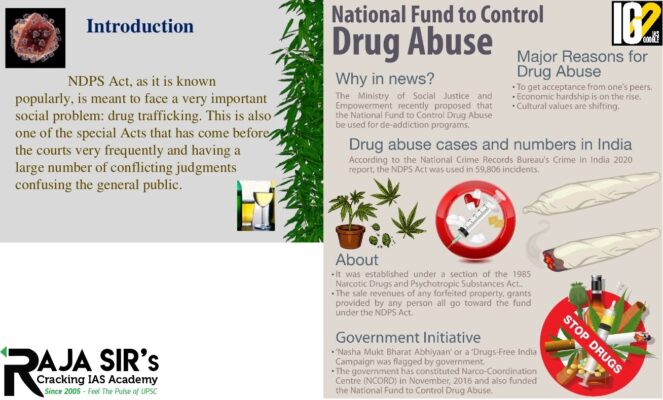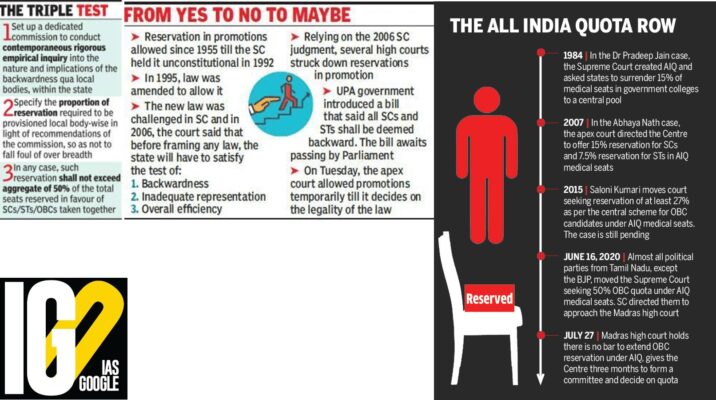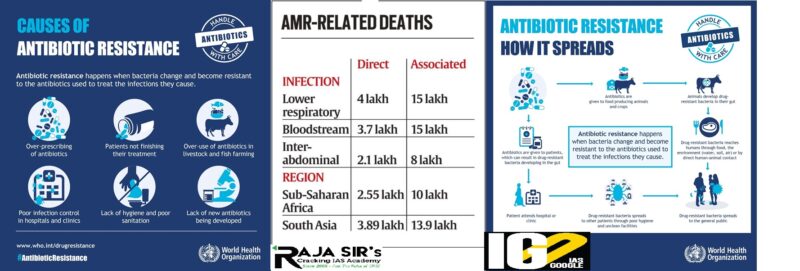- Home
- Prelims
- Mains
- Current Affairs
- Study Materials
- Test Series
 EDITORIALS & ARTICLES
EDITORIALS & ARTICLES
Jan 21, 2022
PLEA CHALLENGES EXPANSION OF DEFINITION OF DRUG
Recently, Delhi High Court asked the Centre to respond to a petition challenging the expansion of the definition of a drug under the Narcotic Drugs and Psychotropic Substances (NDPS) Act.
 Petitioner challenged two notifications (2009 and 2011) under the NDPS Act stating that:
Petitioner challenged two notifications (2009 and 2011) under the NDPS Act stating that:
 The Supreme court verdict:
The Supreme court verdict:
 What is Biomass?
What is Biomass?
 Highlights of study
Highlights of study
 Provision of Marital rape:
Indian Penal Code:
Provision of Marital rape:
Indian Penal Code:
 Challenges in agriculture
Indian agriculture has performed fairly well during the last two decades in terms of record production, diversification towards high value horticulture etc. However, the sector is currently facing some challenges. Some of them are:
Climate Change
Challenges in agriculture
Indian agriculture has performed fairly well during the last two decades in terms of record production, diversification towards high value horticulture etc. However, the sector is currently facing some challenges. Some of them are:
Climate Change
 Eastern Swamp Deer:
Barasingha or Swamp deer
Eastern Swamp Deer:
Barasingha or Swamp deer
 Hunga Tonga-Hunga Ha’apai volcano:
Hunga Tonga-Hunga Ha’apai volcano:
 Petitioner challenged two notifications (2009 and 2011) under the NDPS Act stating that:
Petitioner challenged two notifications (2009 and 2011) under the NDPS Act stating that:
- The notifications were issued in excess of conferred authority.
- The notification has the power of creating a new category of offence by penalising the preparation of a drug on a par with the drug itself.
- There is a violation of Article 14(equality before law) of the Constitution as there is no rational nexus between the classification created by these notifications and the object of the NDPS Act.
- It contended that the NDPS Act requires only the pure narcotic drugs or psychotropic substances to be considered for determining quantities.
- NDPS Act is an act of the parliament to:
- consolidate and amend the law relating to narcotic drugs
- make stringent provisions for the control and regulation of operations relating to narcotic drugs and psychotropic substances.
- The Narcotics Control Bureau was set up by the Central Government in 1986to coordinate drug law enforcement nationally.
- It prohibits a person from the production, cultivation, possession, sale, purchasing, transport, storage, and/or consumption of any narcotic drug or psychotropic substance.
- It provides for the implementation of the provisions of the International Conventions on Narcotic Drugs and Psychotropic Substance.
- It defines terms like addict, drug, cannabis, board, controlled delivery, commercial quantity, corresponding law, conveyance, essential narcotic drug etc.
- It empowers central government to:
- add to or omit from the list of psychotropic substances.
- take measures for preventing and combating abuse of and illicit traffic in narcotic drugs, etc.
- set up The Narcotic Drugs and Psychotropic Substances Consultative Committee.
- It has provision for the prohibition of certain activities relating to property derived from offence.
- It penalises financing of certain illicit activities (such as cultivating cannabis or manufacturing narcotic drugs) or harbouring persons engaged in them.
- Persons found guilty of this offence will be punished with rigorous imprisonment of at least ten years (extendable up to 20 years) and a fine of at least one lakh rupees.
 The Supreme court verdict:
The Supreme court verdict:
- It stated that no state or Union territory can be permitted to hold local body elections with 27% reservation for other backward classes (OBCs) without empirical data on the population and representation of OBCs.
- Currently, there is no provision to provide quotas to OBCs in local body elections, which only have seats set aside for scheduled castes (SCs) and scheduled tribes (STs), apart from women.
- It clarified that states cannot rely on OBC population.
- All states and Union territories (UTs) will have to complete the exercise of gathering empirical data, which will then be examined by the dedicated state commissions.
- The purpose of determining the quantum of OBC quota in local body elections is reflected in the census conducted by the central government.
- It directed that the state election commission (SEC) will have to notify all OBC seats as open category seats for future elections to local bodies if states and UTs fail to satisfy the triple conditions laid down by the top court.
- Set up a commission to conduct rigorous empirical inquiry into nature and implications of the backwardness qua local bodies.
- Specify the proportion of reservation required to be provisioned local body wise in light of recommendations of the Commission, so as not to fall foul of overbreadth
- In any case such reservation shall not exceed 50 per cent of the total seats reserved in favour of SCs/STs/OBCs taken together.
- He focused on the status of bio-mass co-firing and progress of the actions being taken to promote the co-firing in the thermal power plants.
 What is Biomass?
What is Biomass?
- Biomass is plant or animal material used as fuel to produce electricity or heat.
- Example: wood, energy crops, and waste from forests or farms.
- It denotes the biological raw material the fuel is made of.
- Biofuel is usually reserved for liquid or gaseous fuels, used for transportation.
- Co-firing is the combustion of two or more different types of materials at the same time.
- Co-firing can be used to improve the combustion of fuels with low energy content.
- Landfill gas contains large amount of carbon dioxide, which is non-combustible, co-firing it with natural gas increases the heat content of the fuel and improves combustion.
- It can be used to lower the emission of some pollutants.
- Co-firing biomass with coal results in less Sulphur emissions than burning coal by itself.
- Ministry of Power established a National Mission on use of Biomass in coal based thermal power plants (SAMARTH) in 2021.
- Aim: To address the issue of air pollution due to farm stubble burning and to reduce carbon footprints of thermal power generation.
- It would support energy transition in the country and the targets to move towards cleaner energy sources.
- Period: The duration of Mission is 5 years.
- To increase the level of co-firing from 5% to higher levels, to have a larger share of carbon neutral power generation from the thermal power plants.
- To take up R&D activity in boiler design to handle the higher amount of silica, alkalis in the biomass pellets.
- To facilitate overcoming the constraints in supply chain of bio mass pellets and Agro- residue and its transportation to the power plants.
- To consider regulatory issues in biomass co-firing.
- The Mission would have a Steering Committee headed by Secretary (Power) comprising of stakeholders including representatives from Ministry of Petroleum & Natural Gas (MoPNG), Ministry of New & Renewable Energy (MNRE) etc.
- The Executive Committee would be headed by Member (Thermal), CEA.
- National Thermal Power Corporation Limited (NTPC) will provide logistics and infrastructure support in the Mission.
- Sub-Group 1: To be responsible to carry out research on properties/ characteristics of biomass.
- Sub-Group 2: To carry out technical specification and safety aspects including research in boiler design etc.
- To handle the pilot project for higher amount of co-firing of biomass with coal in pulverized coal (PC) fired boilers.
- Sub-Group 3: For resolving the issues of supply chain during the mission period and sensitization programme.
- Sub-Group 4: To select designated labs and certification bodies for testing of Agro-based biomass pellets and Municipal Solid Waste (MSW) pellets
- Sub-Group 5: Be formed on regulatory framework and economics of biomass co-firing in coal based Thermal power plants.
- The proposed mission will also contribute in the National Clean Air Programme (NCAP).
 Highlights of study
Highlights of study
- At least 1.2 million people died in 2019 as a direct result of antibiotic-resistant bacterial infections.
- Antimicrobial resistance (AMR) is now a leading cause of death worldwide, higher than HIV/AIDS or malaria.
- Drug resistance in lower respiratory infections– such as pneumonia – had the greatest impact on AMR disease burden.
- AMR poses a threat to people of all ages.
- Young children were found to be at particularly high risk, with around one in five deaths attributable to AMR occurring in children aged under five years.
- Deaths caused directly by AMR were estimated to be highest in Sub-Saharan Africa and South Asia.
- It highlighted suggestions to combat AMR.
- These include optimising the use of existing antibiotics, taking greater action to monitor and control infections, and providing more funding to develop new antibiotics and treatments.
- It is the ability of microorganisms to persist or grow in the presence of drugs designed to inhibit or kill them.
- Microorganisms that develop antimicrobial resistance are sometimes referred to as “superbugs”.
- It occurs when bacteria, viruses, fungi and parasites change over time and no longer respond to medicines making infections harder to treat and increasing the risk of disease spread, severe illness and death.
- It threatens the effective prevention and treatment of an ever-increasing range of infections caused by bacteria, parasites, viruses and fungi.
- It was launched during 12th FYP in 2012-17.
- Under this programme, AMR Surveillance Network has been strengthened by establishing labs in State Medical College
- Launched in 2017.
- Aim: to effectively combat antimicrobial resistance in India, and contribute towards the global efforts to tackle this public health threat.
- Indian council of medical research (ICMR)has taken initiatives to develop new drugs /medicines through international collaborations in order to strengthen medical research in AMR.
- ICMR along with Research Council of Norway (RCN) initiated a joint call for research in antimicrobial resistance in 2017.
- ICMR along with Federal Ministry of Education and Research (BMBF), Germany has a joint Indo-German collaboration for research on AMR.
- GRAM is the flagship project of the University of Oxford Big Data Institute–IHME Strategic Partnership.
- It was launched with support from the United Kingdom Department of Health’s Fleming Fund, the Wellcome Trust, and the Bill & Melinda Gates Foundation.
- GRAM report estimates deaths linked to 23 pathogens and 88 pathogen-drug combinations in 204 countries and territories in 2019.
- E coli, S aureus, K pneumoniae, S pneumoniae, A baumannii, and P aeruginosa are some example of drug resistance pathogenes.
- World Health Assembly adopted a global action plan on antimicrobial resistance in 2015.
- To improve awareness and understanding of antimicrobial resistance through effective communication, education and training;
- To strengthen the knowledge and evidence base through surveillance and research;
- To reduce the incidence of infection through effective sanitation, hygiene and infection prevention measures;
- To optimize the use of antimicrobial medicines in human and animal health.
- It is celebrated from 18-24 November every year.
- The 2021 theme, Spread Awareness, Stop Resistance.
- Aim: to increase awareness of global antimicrobial resistance and to encourage best practices among the general public, health workers and policy makers to avoid the further emergence and spread of drug-resistant infections.
- Launched in 2015 by World Health Organisation.
- Aim: To fill knowledge gaps and to inform strategies at all levels to combat AMR.
- It incorporates data from surveillance of AMR in humans, surveillance of the use of antimicrobial medicines, AMR in the food chain and in the environment.
 Provision of Marital rape:
Indian Penal Code:
Provision of Marital rape:
Indian Penal Code:
- Section 375 defines rape and lists seven notions of consent that, if vitiated, would constitute the offence of rape by a man.
- The provision exempts sexual intercourse or sexual acts by a man with his own wife, the wife not being under eighteen years of age, under the definition of rape.
- This exemption essentially allows a marital right to a “husband”, who can with legal sanction exercise his right to consensual or non-consensual sex with his “wife”.
- Marital rape immunity stands against the light of the:
- Right to equality (Articles 14)
- Right to life with dignity, personhood, sexual, and personal autonomy (Article 19 and 21)
- It creates an unreasonable classification between married and unmarried women and, by corollary, takes away the right of a married woman to give consent to a sexual activity.
- At the time of marriage, women give irrevocable consent to sexual intercourse with husbands.
- Legal recognition to marital rape will sabotage the institution of marriage.
- Women will weaponize this law against their husbands.
- Alternative legal remedies already exist.
- To look into criminal law reforms following the gangrape and murder of a 23-year-old in Delhi in 2012.
- To remove the marital rape exception in light of India’s obligations under the Convention on the Elimination of All Forms of Discrimination Against Women.
- The committee quoted that marriage should not be regarded as extinguishing the legal or sexual autonomy of the wife.
 Challenges in agriculture
Indian agriculture has performed fairly well during the last two decades in terms of record production, diversification towards high value horticulture etc. However, the sector is currently facing some challenges. Some of them are:
Climate Change
Challenges in agriculture
Indian agriculture has performed fairly well during the last two decades in terms of record production, diversification towards high value horticulture etc. However, the sector is currently facing some challenges. Some of them are:
Climate Change
- Rising temperature along with increased occurrences of extreme weather conditions have made climate change a major threat to Indian agriculture and productivity loss.
- It also results in crop damage by increasing pest and disease attacks.
- The increased incidence of extreme weather conditions like flood and droughts coupled with unseasonal rains also pose a serious threat to the standing crops.
- Current overproduction of crops like rice, wheat and sugarcane, has led to rapid depletion of the ground-water table, soil degradation and massive air pollution.
- Crop residue burnings in the northern states increase the air pollution levels, create health hazards and contribute to global warming.
- The number of farm holdings in India has increased but the area under farming has come down.
- The average size of holdings has decreased
- Marginal and small holdings together constitute 86% of total holdings in India.
- Farmers having less than two hectares (five acres) of land are called small farmers and those having less than one hectare (2.5 acres) are called marginal farmers.
- Agriculture sector engages 49% of the total labour force in the country, its contribution to overall Gross Value Addition (GVA) is only 17% which shows the overdependence of Indian labour force on agriculture
- Agriculture is heavily dependent on rainfall and its spatial distribution, adverse climatic conditions disrupt both aggregate supply and supply chains, imparting large volatility to food inflation trajectory.
- Inefficiencies in the food supply chain and limited level of development of the food processing industry – impact food inflation in India.
- The contribution of food, and particularly, vegetables, to volatility in headline inflation is significantly higher than non-food items.
- It is a measure of the total inflation within an economy, including commodities such as food and energy prices (e.g., oil and gas), which tend to be much more volatile and prone to inflationary spikes.
- The contribution of food, and particularly, vegetables, to volatility in headline inflation is significantly higher than non-food items.
- Improved and effective mechanization should be adopted for in situ residue management such as briquetting and conversion of wastes into fuel forms, various industrial usages and recent intervention of microbial decomposing solution etc.
- There is a need for consolidation of landholdings through land market reforms to increase farm productivity in the country.
- Post-harvest loss can be minimized by development of cold storages, warehousing, packaging and cold transport chain infrastructure.
- Better Post-harvest loss-management and a revamp of co-operative movement through formation of Farmer Producer Organisations (FPOs) can arrest the volatility in food prices and farmers’ income.
- India can move up in the global agricultural value chain by increasing its share of processed food exports.
- India needs to abide with sanitary and phytosanitary (SPS) norms to gain market access in European union and USA.
- A mechanism can be devised to raise awareness among potential exporters on the changing standards which will help them get the phytosanitary certificates.
- Biotechnology and breeding should be used in developing eco-friendly, disease-resistant, climate-resilient, more nutritious and diversified crop varieties.
- Wider use of digital technology and extension services will be helpful in information sharing and generating awareness among the farmers.
- Record Production of Food grains: The average production of food grains has increased significantly in the last decade due to several reason such as:
- Higher agriculture credit, public and private investment, increased usage of quality seeds and fertilizers, expansion of acreage under irrigation and increase in cropping intensity.
- Diversification towards Horticulture Crops:
- Currently it accounts for around 35% of total value of crop output in the agriculture sector.
- The growth in horticulture production has been almost equally driven by growth in area and productivity as against largely productivity driven growth in the case of food grains.
- Growing Importance of Allied Activities:
- Indian livestock sector attained a record growth of 6.6 percent during the last decade (2010-19) with India emerging as a major producer of milk, egg and meat in the world.
- Livestock is emerging as an important source of stable livelihood for not only the small and marginal farmers but also the landless labourers.
- Dynamics of Agriculture Trade:
- The agriculture and allied sector contributed to 2 per cent of the total exports from India in 2020-21.
- India’s share in global trade of agricultural and allied sector products has doubled from 1 per cent in 2000 to 2.2 per cent in 2018.
 Eastern Swamp Deer:
Barasingha or Swamp deer
Eastern Swamp Deer:
Barasingha or Swamp deer
- Barasingha or Swamp deer is a deer species distributed in the Indian subcontinent.
- The swamp deer differs from all other Indian deer species in that the antlers have more than three times.
- Barasingha (Rucervus duvaucelii) has 3 subspecies: Western Swamp Deer, Eastern Swamp Deer, Hard- ground Barasingha.
- Swamp deer is the state animal of Madhya Pradesh.
- Eastern Swamp Deers are endemic to Kaziranga Park.
- It is only found in Assam.
- Their population is concentrated in the central Kohora and Bagori ranges of Kaziranga.
- Wildlife (Protection) Act, 1972: Schedule 1
- CITES: Appendix 1
- IUCN Red List: Vulnerable
- Location: Golaghat and Nagaon District, Assam.
- It is the oldest park in Assam.
- It is located on the edge of the Eastern Himalaya biodiversity hotspot.
- KNP is also declared as:
- National Park (1974) by Union Government of India.
- World Heritage Site (1985) by UNESCO
- Tiger Reserve (2006) by Union Government of India
- Important Bird Area by Birdlife International
- The river Brahmaputra flows on the North of KNP.
- The Karbi Anglong hills are on the South of KNP.
- The National Highway 37 passes through the parking area.
- Fauna: Great Indian one-horned rhinoceros, tigers, elephants, panthers, and bears, Ganges Dolphin etc.
- Landscape: Dense tropical moist broadleaf forests, tall elephant grass, rugged reeds, marshes & shallow pools.
- It has the world's largest population of one-horned rhinoceroses.
 Hunga Tonga-Hunga Ha’apai volcano:
Hunga Tonga-Hunga Ha’apai volcano:
- They are twin uninhabited volcanic islands in the South Pacific region.
- The islands were merged by a volcanic eruption in 2009.
- It lies along the Pacific ‘Ring of fire’.
- It is over 60 kilometers from the island nation of
- It is part of the highly active Tonga-Kermadec Islands volcanic arc.
- The arc is a subduction zone extending from New Zealand north-northeast to Fiji.
- The Pacific ‘Ring of Fire’ is an area along the Pacific Ocean.
- It is home to about 75 per cent of the world’s volcanoes.
- About 90 per cent of the world’s earthquakes occur here.
- It is stretched over 40,000 kilometers and traces from New Zealand in a circular arc covering Tonga, Kermadec Islands and stretching eastward to the Aleutian Islands, then southward along the western coast of North & South America.
- The area is along several tectonic plates including the Pacific plate, Philippine Plate, Juan de Fuca plate, Cocos plate, Nazca plate and North American plate.
- The movement of the plates or tectonic activity makes the area witness abundant earthquakes and tsunamis.
- Along much of the Ring of Fire, the tectonic plates move towards each other creating subduction zones.
- One plate gets pushed down or is subducted by the other plate.
- As this subduction happens, rocks melt, become magma and move to Earth’s surface and cause volcanic activity.









 Latest News
Latest News General Studies
General Studies